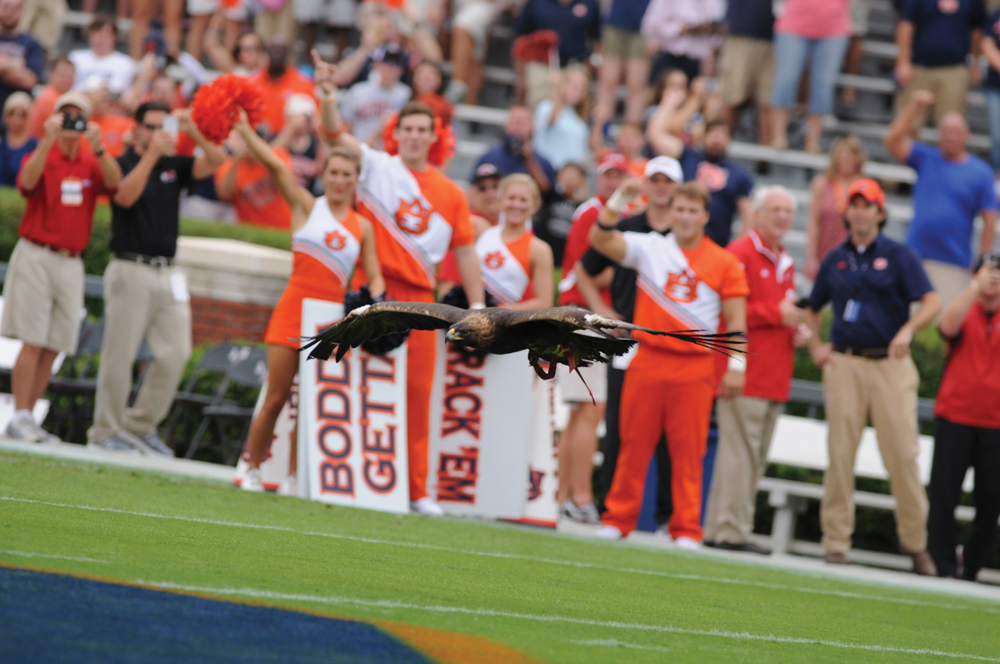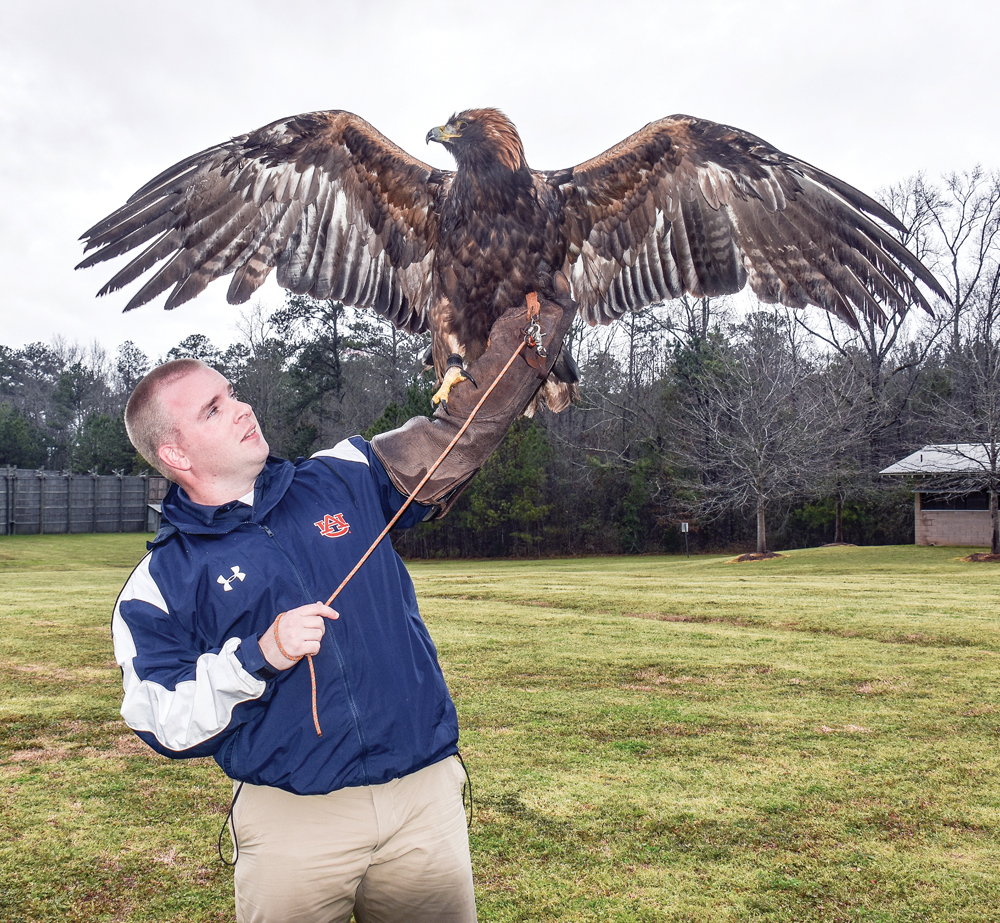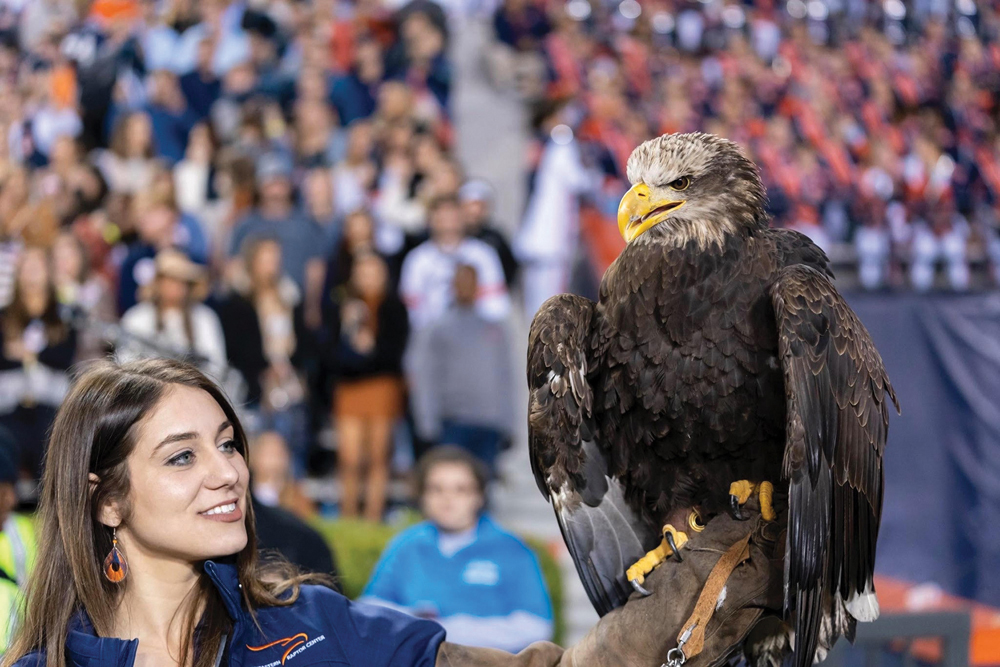Training is rigorous for Auburn mascots who represent heritage, tradition

Photo courtesy of Auburn UniversityWar Eagle VII, Nova, Flying in Jordan Hare Stadium on game day
By Emmett Burnett
Behind a Lee County security gate, down a winding forest path, resides a noble flock. Birds of prey live here, representing one of America’s most famous mascots. They are the few, the proud, the War Eagles.
Perhaps you watched in awe as the proud bird soared through Jordan Hare Stadium. It is more than a show. “War Eagle” represents Auburn University’s heritage, competitive battle cry, and often replaces hello and goodbye as salutations.
The winged wonders reside and train at the Southeastern Raptor Center, about two miles from campus. Auburn’s raptors of renown are impressive during televised football games, but you should see one up close. The Center’s Andrew Hopkins does, every day.
“Eagles are bigger than most people imagine,” Andrew says, hoisting Aurea, a golden eagle, on his arm. Almost on cue, she stretches her 6-foot wingspan as a reporter’s jaw drops.

Auburn’s current four eagles consist of three in its frequent flyer program and one retiree. They originally joined the program with injuries prohibiting a return to the wild.
Aurea flew in most of Auburn’s 2019 football pregame shows. Spirit, a bald eagle, is her alternate. The new kid and trainee is also a bald eagle, Independence (Indy). The only male on the list is Nova, the retiree golden eagle who dominated Auburn skies from 2012-2016.
Though others participate, only golden eagles – the official school mascot – can hold the title “War Eagle.” Nova and Aurea are officially War Eagle 7 and War Eagle 8 respectively.
For active duty birds, training is rigorous. Don’t try this at home. Actually, you can’t. Federal laws prohibit so much as touching an eagle without a permit; Auburn’s trainers are licensed.
The instructor’s job is straightforward. All they have to do is teach a wild raptor, capable of flying 120 mph, with a wingspan that can hide a coffee table, while packing talons stronger than a lion’s jaw, to soar over 90,000 screaming fans and return. What could possibly go wrong?
“It’s all about positive reinforcement and repetition,” says Andrew. “We train eagles to do what we want them to do and reward them for doing it.” The key is the lure – a circular leather pouch the birds have been trained to associate with food.
“To them, it’s a magic button,” adds co–trainer, Auburn student and Mobile native, Amanda Sweeney. When the beak pecks the pouch, food follows.
On day one, the wild bird is taught to perch on the handler’s arm. Once that task is mastered, War Eagle Class moves offsite to Jordan Hare Stadium.
“We start with little steps,” says Andrew. First, they place the eagle – at this point leg tethered to trainer – on the stadium’s lower ledge and teach it to hop down on the football field for food. Days later, the bird is moved higher up into the stadium. It must hop and fly greater distances for a treat.

Photo courtesy of Amanda Sweeney
Eventually, the task is performed from high in the stadium and the eagle now flies down the field to tap the lure to snack. “Then we start the entire process all over again,” Andrew adds. “Only this time without the tether.”
As for noise, crowd roars do not faze eagles. “We do elementary school shows all year,” Andrew notes, though onsite appearances have dropped dramatically during the pandemic. “Being around large crowds of school children helps acclimate our eagles to human racket. During game shows, the War Eagle doesn’t care if the crowd is 100 or 90,000. It is totally focused on doing its job and being rewarded for it.”
At game time, three eagles assemble in the stadium. One will fly, one is the alternate, and the third is a trainee observing.
“We like the War Eagle to fly with the wind, not against it,” Andrew says. “Flying against it gives the bird too much lift.” As for weather, it will fly in drizzle rain but not in wind speeds exceeding 15 mph.
Before the show, a pre-flight check is completed. Decisions are made within minutes of show time if the bird is ready. “They all have quirks,” Andrew says. “You learn their personalities and work around it.”
Amanda continues, “Eagles are different by species and it shows in their flight style. In the wild, bald eagles eat fish but golden eagles prey on fast animals such as jack rabbits. They fly faster than bald eagles and hit the lure very hard.”
All War Eagles have tracking devices attached to their legs but none of them care. Once released in the stadium, it has a choice: Fly as trained and return for a yummy dead rodent, or never look back and be free as a bird. “We never know what route it will fly,” says Andrew and he laughs, “I’ve had several years taken from my life doing this.”
During training or game day performances, to date, Auburn has never witnessed an eagle escapee. “When it’s time to call it down we run out to the field with the lure,” adds Amanda. “In flight, the eagle looks down at the lure it associates with food and down it comes – hopefully to the 50-yard line.”
As of press time, all home pre-game shows are still on. “As long as there are fans in the stadium, we will fly,” Andrew says.
From release, to return, the show is over in about 90 seconds. The eagle team runs off the field. Football players run on it. Inevitably a loyal home team fan base erupts in song, “War Eagle, fly down the field, ever to conquer, never to yield.”
Aurea and company show how it’s done.




